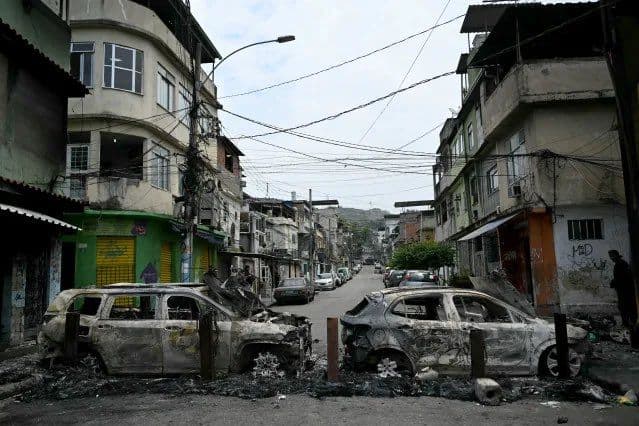Lifestyle
Major Police Operation in Rio De Janeiro Targets Drug Cartels

A significant police operation unfolded in Rio de Janeiro on October 28, 2025, targeting members of the notorious drug cartel, Comando Vermelho. The operation, the largest of its kind in Brazil’s history, involved over 2,500 officers and soldiers, supported by helicopters, armored vehicles, and drones. It took place primarily in the northern favelas, areas identified as hideouts for high-profile fugitives.
According to the Civil Police of Rio de Janeiro, the extensive raid resulted in 64 fatalities, including four police officers, with an additional 15 officers sustaining injuries. The operation aimed to dismantle the cartel’s infrastructure and apprehend individuals listed on police wanted lists. Authorities have reported the arrest of 81 suspects during the operation.
As security forces approached, members of the drug cartel responded with gunfire and set up makeshift barricades, utilizing 71 buses to obstruct police movements. The violence escalated dramatically, leading to widespread chaos in affected neighborhoods.
In retaliation, cartel members reportedly used drones to launch explosive devices at police forces. The operation resulted in the seizure of over 90 firearms, highlighting the scale of the cartel’s firepower.
Government Response and Local Impact
Victor Santos, the Secretary of Public Security for Rio de Janeiro, emphasized that this operation was meticulously planned and executed without federal government support. “Approximately 280,000 people live in the areas impacted by this operation,” Santos stated. “We deeply regret the injuries, but this is a necessary and strategically planned action that will continue.”
Investigations leading up to the operation identified 94 gang members from Comando Vermelho hiding in the Alemão and Penha complexes. They face multiple charges, including murder, drug trafficking, and car theft. These areas, situated in mountainous regions surrounded by forests, facilitate the escape of criminals.
Police assert that the directives for territorial control come from two prominent gang leaders: Márcio dos Santos Nepomuceno, known as Marcinho VP, who is currently incarcerated, and Edgar Alves de Andrade, also known as Doca or Urso, who remains at large with an extensive criminal record.
Over the past four years, Doca has reportedly overseen the cartel’s expansion into nearly 50 neighborhoods within the capital and the Baixada Fluminense area. Among these, the Grande Jacarepaguá region has seen significant cartel activity, with the gang’s influence expanding rapidly over the last three years.
Calls for Increased Federal Support
Cláudio Castro, the Governor of Rio de Janeiro, expressed concern over the lack of federal support for the operation. “Unfortunately, just like at every instance during this term, we have no support in terms of armored vehicles or federal security forces,” Castro stated. He stressed the need for a robust federal response to combat the escalating violence. “For a war like this, which transcends urban security, we truly need much greater support, possibly even from the Armed Forces, as this struggle has surpassed all concepts of public safety.”
The serious nature of this operation illustrates the ongoing challenges faced by local authorities in addressing drug-related violence and cartel activity in Brazil. As the country grapples with these issues, the implications for public safety and community stability remain critical.
-

 Entertainment2 months ago
Entertainment2 months agoAnn Ming Reflects on ITV’s ‘I Fought the Law’ Drama
-

 Entertainment3 months ago
Entertainment3 months agoKate Garraway Sells £2 Million Home Amid Financial Struggles
-

 Health2 months ago
Health2 months agoKatie Price Faces New Health Concerns After Cancer Symptoms Resurface
-

 Entertainment2 months ago
Entertainment2 months agoCoronation Street’s Carl Webster Faces Trouble with New Affairs
-

 Entertainment2 months ago
Entertainment2 months agoWhere is Tinder Swindler Simon Leviev? Latest Updates Revealed
-

 Entertainment3 months ago
Entertainment3 months agoKim Cattrall Posts Cryptic Message After HBO’s Sequel Cancellation
-

 Entertainment2 months ago
Entertainment2 months agoOlivia Attwood Opens Up About Fallout with Former Best Friend
-

 Entertainment2 months ago
Entertainment2 months agoMasterChef Faces Turmoil as Tom Kerridge Withdraws from Hosting Role
-

 Entertainment3 months ago
Entertainment3 months agoMarkiplier Addresses AI Controversy During Livestream Response
-

 Entertainment3 months ago
Entertainment3 months agoSpeculation Surrounds Home and Away as Cast Departures Mount
-

 World2 months ago
World2 months agoCole Palmer’s Mysterious Message to Kobbie Mainoo Sparks Speculation
-

 Entertainment2 months ago
Entertainment2 months agoITV’s I Fought the Law: Unraveling the True Story Behind the Drama















